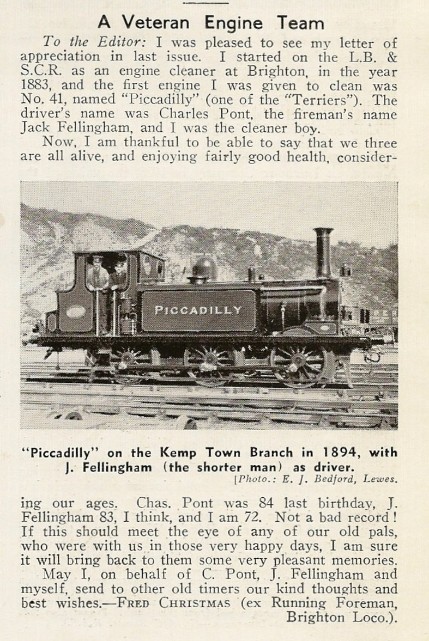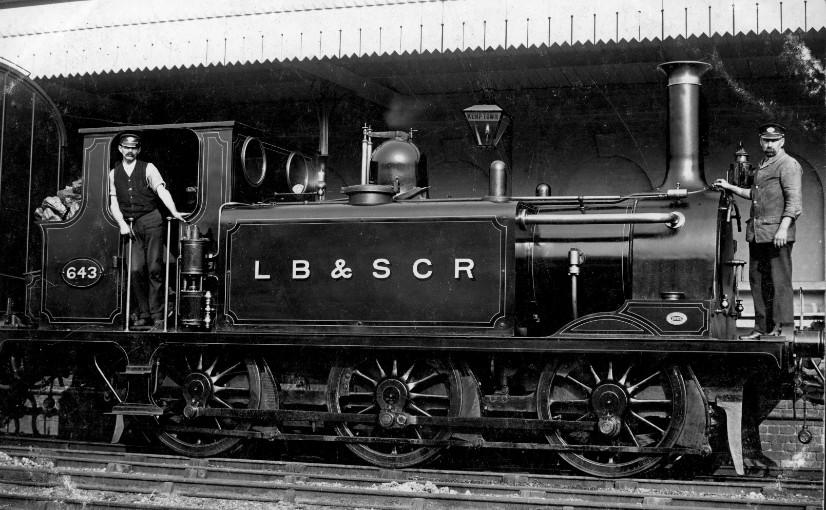
AMALGAMATED SOCIETY OF RAILWAY SERVANT
Founded 1871
1913 amalgamated to become the National Union of Railwaymen
In 1872 branches of the A.S.R.S. were formed on the L.B.S.C.R., these branches included Enginemen and railwaymen from all the various railway grades within the L.B.S.C.R.
THREE BRIDGES
TUNBRIDGE WELLS
BRIGHTON No.2
Railway accidents on the
L.B.S.C.R.

Evidence given of excessive hours
worked by Enginemen in 1877
Accidents, due mainly to the negligence and greed of the railway companies, were commonplace. In 1874-6, for example, there nearly four thousand people killed on the railway and over sixteen thousand injured. Two thousand of those killed and ten thousand of the injured were railway servants. The railway companies took no responsibilities for the injuries and deaths caused by their own rapacity.
The Royal Commission on Railway Accidents of 1877 revealed that drivers were accustomed to working four or five hours overtime a day, sometimes ten hours, this was usually unpaid. An eighteen or nineteen hour day was not unusual.
A Driver Weston gave evidence before the Royal Commission that on one occasion:
“I had been on hours sixteen hours a day in succession and on the third day I went on the engine at 7.30 in the morning and left it at 11 or 12 at night. I took my meals and everything on the engine. I never left the engine. I complained to my foreman and told him that I found difficulty in keeping my eyes open. Upon the third day I told him that I could not hold myself responsible if anything occurred to the engine or the passengers and that it was unfair to force us to do it. He reported this is to Mr Thomas Wheatley, Locomotive Superintendent, London North Western (Southern Division) . He called me up and said, ‘Weston unless you retract those words, I will dismiss you’. I said, ‘Mr Wheatley, you have the power to dismiss me but I cannot retract what I said’. ”
In fact Weston was given the option of being reduced to a branch line or being dismissed. He left.
On the Brighton Line Mr Woodhead gave the case of a Engineman who “made 89 hours in 6 Days without a Sunday, and another who worked 16 hours, and 14 hours, and 20 ¼ hours, and 23 ¼ hours, and 16 ½ hours in his week”
*It is not known what the loco shed, Driver Weston was located
E.J. BEDFORD COLLECTION
Left ~ Right: Fireman Jack Fellingham & Driver Charles Pont.
Driver Jack Fellingham was bit of a celebrity among his workmates because of the long
period which he had spent exclusively on the Kemp Town service. For about twenty years,
first as a fireman and then as a driver, he had done nothing else, just thousands and
thousands of trips from Brighton to Kemp Town and back. It might have been continued thus, but for an official edit which said, in effect,
‘You can't earn a driver's top rate unless you do main line work'.
In other words if Jack wanted to take his place among the men on top rate, he would have to
broaden his horizons. It was a now or never situation and it caused some amusement among
his colleagues. "He'll never do it!", they told each other, "He's never been anywhere but
Kemp Town!” Jack confounded them all by doing it and spent about six months 'learning the
road' to London, Portsmouth, Hastings and many other routes that a top rate driver had to
go.
Extracted from the book
Yesterday Once More
By Fred Rich
According to the 1925 Southern Railway Seniority Book, there was four Fellinghams and their seniority dates are
Jack Fellingham
started at Brighton in May 1877.
John Fellingham
started at Brighton on the
8th September 1903. (John later transferred to Brighton's motorman's depot in 1936 where he remained until his retirement in 1950).
Sid Fellingham
started on the16th August 1909.
E. Fellingham
started on the 1st February 1916.

E.J. BEDFORD COLLECTION
L~R: Fireman Jack Fellingham & Driver Charles Pont
E.J. BEDFORD COLLECTION
L~R: Fireman Jack Fellingham & Driver Charles Pont

E.J. BEDFORD COLLECTION
Photo was taken at Kemp Town some time after 1877 “Gypsy Hill"
Railway accidents on the
L.B.S.C.R.
WESTINGHOUSE AIR BRAKES
In December 1877 the LBSCR informed the Board of Trade that it had adopted the Westinghouse air brake and that fifty of their locomotives and 500 carriages would be fitted.
Prior to this the passenger train braking was only carried out by the engine, tender and brake van or vans. As speed increased, this proved insufficient.
AMALGAMATED SOCIETY OF RAILWAY SERVANT
Founded 1871
1913 amalgamated to become the National Union of Railwaymen
In 1872 branches of the A.S.R.S. were formed on the L.B.S.C.R., these branches included Enginemen and railwaymen from all the various railway grades within the L.B.S.C.R.
THREE BRIDGES
TUNBRIDGE WELLS
BRIGHTON No.2